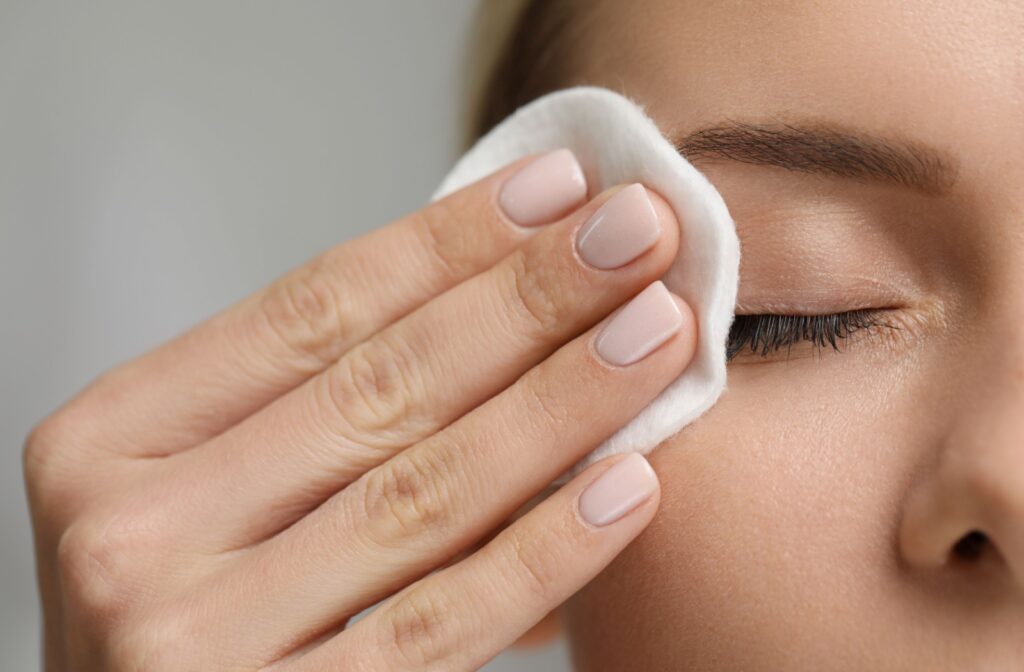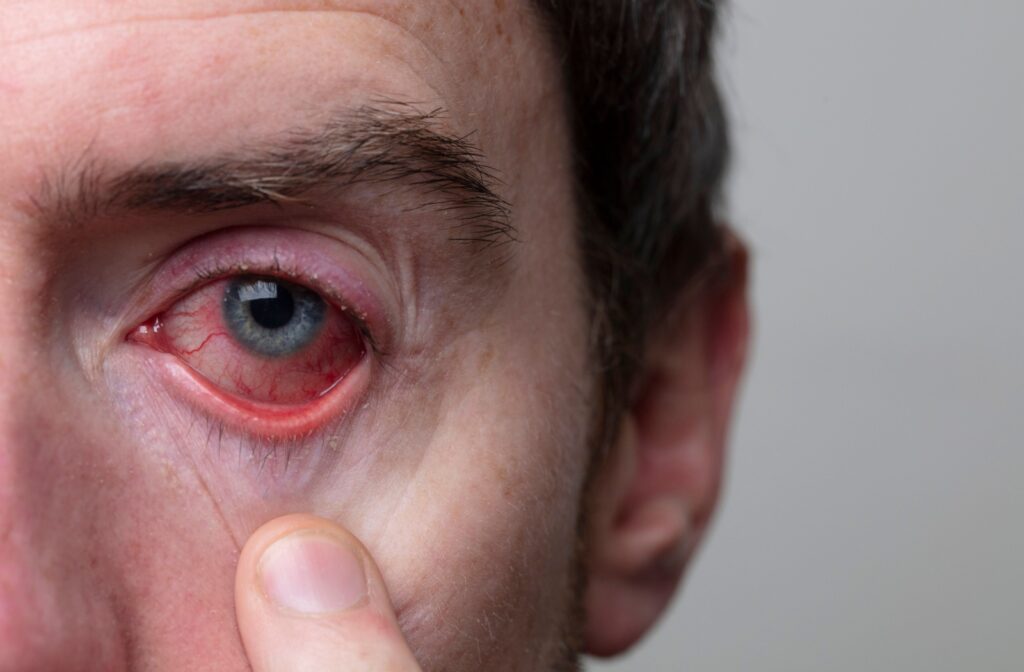Blepharitis is a common eye condition characterized by the onset of dry, flakey, and crusty skin that develops along the eyelids. While this isn’t a serious condition, blepharitis flare-ups can result in discomfort and irritation, impacting overall quality of life.
The onset of irritation, coupled with the condition’s characteristic flakey skin, can lead others to wonder if this eye condition is contagious like pink eye.
Fortunately, blepharitis isn’t contagious. There are several ways of preventing future flare-ups, and effective treatment options are available for those experiencing blepharitis.
Understanding Blepharitis
Blepharitis refers to an ocular condition that results in inflamed eyelids, and affects people of all ages. It usually occurs at the base of the eyelashes, resulting in red, irritated, and swollen eyelids.
Blepharitis develops when the tiny oil glands near the base of your eyelashes become clogged. This blockage can be caused by several factors, including:
- Bacterial Infections: The overgrowth of normal bacteria on the skin can lead to inflammation.
- Skin Conditions: Conditions like seborrheic dermatitis or rosacea can contribute to the onset of blepharitis.
- Gland Dysfunction: Blocked oil glands in the eyelids can prevent proper lubrication, promoting inflammation.
- Demodex Mites: These tiny mites naturally inhabit the skin, especially along areas with oil glands, but overpopulation of these mites can contribute to the development of blepharitis.
When these oil glands can’t secrete their oils effectively, dry eyes and irritation can result, fostering an environment where inflammation occurs.
Blepharitis manifests through various symptoms that can range from mild to severe. The most common symptoms include:
- Red and swollen eyelids
- Itchy or burning sensation
- Crusty or sticky eyelids, especially upon waking
- Sensitivity to light
- Watery eyes
- A gritty sensation or foreign body in the eye
Recognizing these symptoms early can help in seeking timely treatment and preventing potential complications.
Blepharitis can have a significant impact on vision and overall ocular health due to the inflammation and irritation it causes. While it’s not considered a serious eye condition, if left unmanaged, blepharitis can lead to further eye concerns and irritation, including:
- Dry eye
- Recurrent styes or chalazia
- Corneal damage
- Increased susceptibility to conjunctivitis
Is Blepharitis Contagious?
The characteristic redness, flaking, and crusting along the eyelids that is associated with blepharitis can lead others to question if this condition is contagious like pink eye. The good news is that blepharitis isn’t contagious.
Because it’s not caused by a virus or easily transmissible bacteria, you don’t have to worry about spreading blepharitis through casual contact or being near others.
Hygiene Tips to Prevent the Spread
While blepharitis itself isn’t contagious, maintaining good hygiene can prevent the exacerbation of symptoms and the development of secondary infections. Some hygiene tips to incorporate into your routine (and to continue to practice regardless of whether you’re experiencing an eye condition) include:
- Regularly Clean Your Eyelids: Use a gentle, non-irritating cleanser or eyelid wipe to clean your eyelids daily.
- Avoid Sharing Personal Items: Don’t share towels, washcloths, or cosmetics with others.
- Hand Hygiene: Always wash your hands before touching your eyes.
- Remove Makeup: Make sure to remove all makeup, especially eye makeup, before going to bed.
By following these hygiene tips, you can significantly reduce the risk of developing or worsening blepharitis.

Blepharitis Treatment & Prevention
Fortunately, blepharitis is a very treatable condition.
One key way to effectively prevent and treat blepharitis is by visiting your optometrist for a thorough health examination. Your eye doctor will determine the underlying cause and develop the most appropriate treatment plan.
There are several effective treatment options for blepharitis, which include:
- Warm Compress Masks: Applying a warm compress to your eyelids and gently massaging the area helps loosen clogged oil glands, promoting better oil secretion and reducing irritation.
- Eyelid Wipes: Using specialized eyelid wipes or a warm soapy cloth to remove debris and oil build-up can help maintain eyelid hygiene and reduce inflammation and irritation.
- Topical Antibiotics: If a bacterial infection is suspected to be the underlying cause, your doctor may prescribe antibiotic ointments or drops.
- Oral Antibiotics: In more severe or persistent cases, oral antibiotics may be necessary to control inflammation and tackle any underlying bacterial issues.
- Steroid Eyedrops or Ointments: For those experiencing significant inflammation, these medications can provide relief and reduce swelling.
In addition to treating blepharitis, it’s important to take preventive measures to avoid flare-ups. In addition to practicing good eye hygiene, here are some ways you can prevent the onset and spread of blepharitis:
- Manage Underlying Conditions: Addressing skin conditions like dandruff or rosacea can help prevent flare-ups, especially if these flare-ups are ongoing and frequent.
- Avoid Eye Irritants: Stay away from known irritants, or minimize your exposure to harsh cosmetics and environmental pollutants like smoke, which can aggravate symptoms.
- Follow a Healthy Diet: Incorporating omega-3 fatty acids into your diet can help reduce inflammation and support overall ocular health.
By integrating these preventive measures into your daily routine, you can keep blepharitis under control!
Schedule an Appointment
Blepharitis may not be a serious eye condition, but it’s certainly one that requires attention and care. Understanding its causes, symptoms, and treatment options, and visiting your optometrist helps to manage this condition and maintain your ocular health.
Connect with our team at West Valley Dry Eye to schedule an appointment for any eye conditions you may be experiencing.


